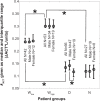Heparin requirements for full anticoagulation are higher for patients on dabigatran than for those on warfarin - a model-based study
- PMID: 25709508
- PMCID: PMC4327399
- DOI: 10.2147/CPAA.S72185
Heparin requirements for full anticoagulation are higher for patients on dabigatran than for those on warfarin - a model-based study
Abstract
Purpose: Dabigatran (D) is increasingly used for chronic anticoagulation in place of warfarin (W). These patients may present for catheter-based procedures requiring full anticoagulation with heparin. This study compares the heparin sensitivity of patients previously on dabigatran, on warfarin, or on no chronic anticoagulant during ablation of atrial fibrillation.
Patients and methods: In a retrospective study of patients treated with D, W, or neither drug (N) undergoing atrial ablation, the timing of heparin doses and resulting activated clotting times were collected. First, the initial activated clotting time response to the first heparin bolus was compared. Then, a non-linear mixed effects modelling (NONMEM) analysis was performed, fitting a pharmacokinetic and -dynamic model to the entire anticoagulation course of each patient. Resulting model coefficients were used to compare the different patient groups.
Results: Data for 66 patients on dabigatran, 95 patients on warfarin, and 27 patients on no anticoagulation were retrieved. The last dose of dabigatran or warfarin had occurred 27 hours and 15 hours before the procedure. Groups D and N both responded significantly less (P<0.05) to the initial heparin bolus than Group W (approximately 50%). Likewise, the model coefficients resulting from the fit to each group reflected a significantly lower heparin sensitivity in groups D and N compared to W. Clearances of the heparin effect in the model did not differ significantly among groups.
Conclusion: Patients on warfarin with an average INR of 1.5 or higher are more sensitive to heparin than patients not previously anticoagulated or patients who discontinued dabigatran 27 hours earlier (approximately two half-lives) warfarin.
Keywords: NONMEM; PKPD model; atrial fibrillation; electrophysiology.
Figures



Similar articles
-
[Impact of different anticoagulation therapies on heparin dosage applied to atrial fibrillation patients undergoing atrial fibrillation catheter ablation].Zhonghua Xin Xue Guan Bing Za Zhi. 2019 Aug 24;47(8):602-607. doi: 10.3760/cma.j.issn.0253-3758.2019.08.003. Zhonghua Xin Xue Guan Bing Za Zhi. 2019. PMID: 31434430 Chinese.
-
Efficacy and safety of periprocedural dabigatran in patients undergoing catheter ablation of atrial fibrillation.Circ J. 2012;76(10):2337-42. doi: 10.1253/circj.cj-12-0498. Epub 2012 Jun 30. Circ J. 2012. PMID: 22785434 Clinical Trial.
-
Safety of novel oral anticoagulants compared with uninterrupted warfarin for catheter ablation of atrial fibrillation.Ann Pharmacother. 2015 Mar;49(3):278-84. doi: 10.1177/1060028014563950. Epub 2014 Dec 16. Ann Pharmacother. 2015. PMID: 25515868
-
Safety and efficacy of dabigatran compared with warfarin for patients undergoing radiofrequency catheter ablation of atrial fibrillation: a meta-analysis.Can J Cardiol. 2013 Oct;29(10):1203-10. doi: 10.1016/j.cjca.2013.07.005. Epub 2013 Aug 29. Can J Cardiol. 2013. PMID: 23993352 Review.
-
Dabigatran and atrial fibrillation: the alternative to warfarin for selected patients.Prescrire Int. 2012 Feb;21(124):33-6. Prescrire Int. 2012. PMID: 22413715 Review.
Cited by
-
Uninterrupted DOACs Approach for Catheter Ablation of Atrial Fibrillation: Do DOACs Levels Matter?Front Cardiovasc Med. 2022 Mar 29;9:864899. doi: 10.3389/fcvm.2022.864899. eCollection 2022. Front Cardiovasc Med. 2022. PMID: 35425821 Free PMC article. Review.
-
Periprocedural Anticoagulation Management for Atrial Fibrillation Ablation: Current Knowledge and Future Directions.Curr Treat Options Cardiovasc Med. 2018 Jan 25;20(1):3. doi: 10.1007/s11936-018-0600-8. Curr Treat Options Cardiovasc Med. 2018. PMID: 29368193 Review.
References
-
- Boehringer Ingelheim Pharmaceuticals, Inc . Dabigatran [package insert] Ridgefield, CT: Boehringer Ingelheim Pharmaceuticals, Inc; 2012.
-
- Lakkireddy D, Reddy YM, Di Biase L, et al. Feasibility and safety of dabigatran versus warfarin for periprocedural anticoagulation in patients undergoing radiofrequency ablation for atrial fibrillation: results from a multicenter prospective registry. J Am Coll Cardiol. 2012;59(13):1168–1174. - PubMed
-
- Winkle RA, Mead RH, Engel G, Kong MH, Patrawala RA. The use of dabigatran immediately after atrial fibrillation ablation. J Cardiovasc Electrophysiol. 2012;23(3):264–268. - PubMed
-
- McAvoy TJ. The biologic half-life of heparin. Clin Pharmacol Ther. 1979;25(3):372–379. - PubMed
-
- Wachsman M, Mielke CH, Jr, Hayes JA, Baker D. The use of time step simulations and difference equations (TSSADEQ) in modeling heparin pharmacokinetics. J Clin Pharmacol. 2000;40(10):1121–1128. - PubMed
LinkOut - more resources
Full Text Sources

